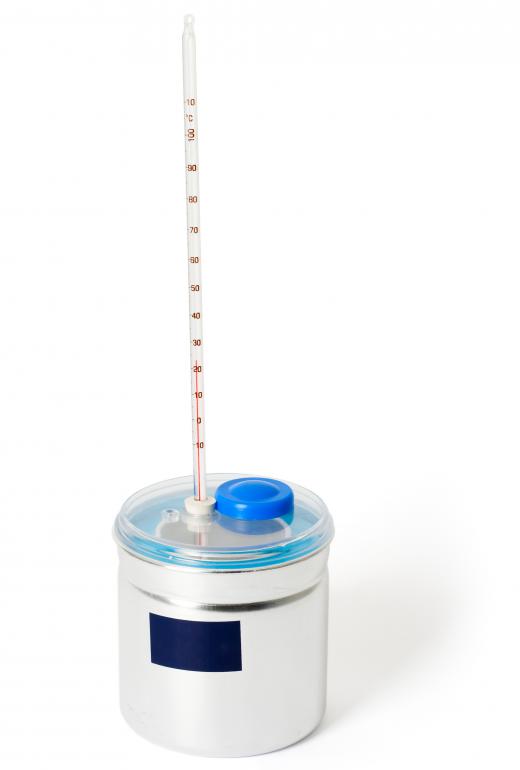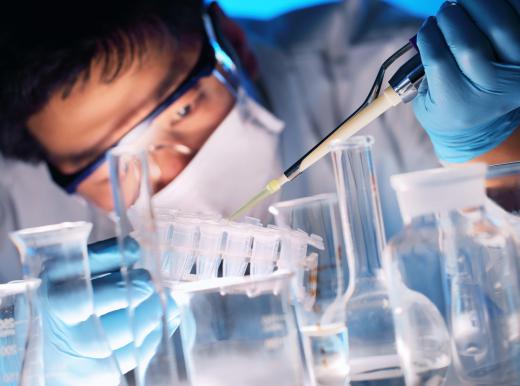What is Calorimetry?
On its most basic level, calorimetry is the science of heat absorption and loss. It measures the energy changes in a given substance and gives observers and researchers some idea of how much energy is required to break that substance down or cause it to change. A chemical process may either absorb or release energy, and many times this energy is in the form of heat. Nutritional analysis is one of the most common uses for this information. Food breaks down into energy during digestion and this comes at a measurable energy cost, but metals and other substances can also break down, usually when exposed to environmental heat. Knowledge of these circumstances is important for people in engineering and other related trades. Calculations are normally made using a device known as a calorimeter, and depending on the nature and needed specificity of the testing, these can be either very simple or quite complex. The key is usually the ability to consistently measure temperature changes over time.
Basic Concept

Calorimetry as a science is somewhat complicated, and understanding its deeper workings usually requires both a firm understanding of basic physics and thermodynamics. From a more basic perspective, though, the calculations can be seen as ways of determining a substance’s inherent energy based on the heat it either puts out or absorbs. Temperature measurements are usually the central focus. Observing the temperature shifts in a substance over time can give measurable insight into how much energy it is either taking or giving.
Why It’s Important

Most compounds, everything from hard metals to food substances, contain raw energy, but it doesn’t usually do anything unless the substance undergoes some sort of change. When things are heated, for instance, or exposed to other environmental factors, latent energy will often convert into something that is measurable. Understanding how substances break down and the conditions under which this happens is really important to a number of different applications.
How It Works

Scientists typically use tools known as calorimeters to measure the amount of heat a reaction absorbs or releases. There are a couple of different types. Many high school science students are familiar with a very basic form of calorimetry conducted in a foam cup; the cup acts as an insulator and students use it to measure temperature shifts of water over time. The results of this sort of experiment can give students a basic grasp of energy measurements, but aren’t usually precise enough for more serious endeavors.
More serious calculations usually need more intensive tools. A device known as a bomb calorimeter is a very common example. This piece of equipment is typically made out of a steel casing — a "bomb" — that will not change in volume. The reactants are placed inside of the bomb and the bomb placed inside of another container filled with water. The temperature of the water is then noted, and the reaction, often in the form of an explosion, is allowed to take place.
Running the Experiment
Before the reaction takes place, the substances in the bomb are commonly placed under extreme pressure by the addition of oxygen. Scientists must also take the heat capacity of the device into account before they can determine how much heat is absorbed or released. The heat capacity is a measurement of how much heat it takes to raise the device one degree Celsius. After the reaction, the temperature of the water is taken. After all these values are known, then a scientist is able to calculate the amount of heat that was absorbed or lost.
Role in Nutritional Calculations
Calorie calculations are used in many applications but most notably with food. Food items all contain a certain caloric content, which is basically a description of how much energy they provide — which in turn makes a statement about how much work a person will have to produce to “burn off” or “work off” that intake. Most packaged food manufacturers around the world calculate the caloric content of the goods they produce and print this measurement on the packaging.
Broadly speaking, a calorie is a measurement of heat, and it represents how much heat is needed to increase the temperature of one gram of pure water one degree Celsius. The capital-C Calorie commonly featured on food packaging is actually a kilocalorie: that is, 1,000 calories. Some countries do not use calories as their food energy measurement, but rather describe food energy in terms of joules. There are approximately 4.2 joules in every calorie.
When calorimetry is used to determine the calorie content of food, the dehydrated food items are placed in a bomb calorimeter. The food item is then combusted in order to find out the amount of energy the food has. Thus, when a person eats an item that has 100 kilocalories (about 4,200 joules), it will take 100 kilocalories (about 4,200 joules) for the body to burn it.
AS FEATURED ON:
AS FEATURED ON:













Discussion Comments
I saw a device looking like a scale, which was used to measure the (energy) joules in food. Where can I get one? It will be handy when doing shopping.
Post your comments